The Safe Routes National Partnership has just released a new report detailing how five communities around the country — including Portland — have used Safe Routes to Schools programs to create safer walking and biking environments.
Titled Safe Routes to School: Putting Traffic Safety First (PDF), the report details how communities from Florida to California are participating in encouragement programs and making safety improvements that are affordable yet have “profound effects on keeping children safe while also improving physical health and the environment.”
The report puts statistics behind the Safe Routes rhetoric and will provide much-needed ammunition for advocates and planners looking to spur funding and policy changes that will get more kids walking and biking to school. The report also tries to show the urgency of the issue, citing statistics that show as family biking has increased in America, the percentage of children’s bicycle-related fatalities that take place in the street is also on the rise:
Currently, an estimated 88 percent of children’s bicycle-related fatalities take place in the street, an increase from 38 percent in 1990 and 47 percent in 2005.
As for Portland, the report features an encouraging stat that speaks to our city’s traffic safety efforts:
Over the past 22 years, Portland’s total traffic fatalities have declined six times faster than the trend in the rest of the country. At the same time, bicycle commuting has increased three-fold in 12 years.
As one of their case studies for Safe Routes success, the report focuses on Vestal Elementary School. Vestal is located on NE 82nd Ave (between Burnside and Glisan), which is one of the most dangerous streets in Portland. According to the report, ODOT analysis has revealed that 82nd has more crashes, injuries, and fatalities than any other street in the city and that it is home to five of the 24 most dangerous intersections in Portland.
Because of these stats, PBOT’s Safe Routes team has made Vestal one of their focus schools. The City has spent $97,000 on small traffic safety infrastructure projects. PBOT also partnered with the Portland Police Bureau to increase enforcement around the school (Vestal is one of just 100 school zones the PPB focuses on). According to the report, during the second week of September 2009, officers wrote 1,304 citations, issued 24 warnings, and arrested two people at 46 schools. About 90 percent of the citations issued were for speeding in a school zone.
PBOT’s Safe Routes efforts at Vestal seem to be working. Not only has the perception of safety among parents at the school improved, but the study also cites ODOT crash analysis from 1998 to 2007 that shows a steady decrease in total crashes and crash severity. “For example, total crashes decreased by nearly 25 percent and there was a 32 percent decline in pedestrian injuries from crashes.”
The Safe Routes National Partnership is gearing up to lobby Congress for funding in the new federal transportation bill. According to the group’s founding director Deb Hubsmith, they’ll ask for a tripling of funding for the program, from its current level of $183 million per year to $600 million per year.
Learn more about Safe Routes to School:


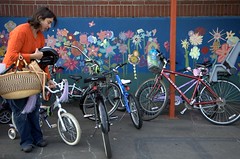
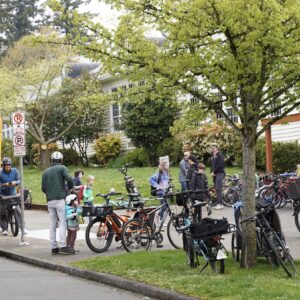
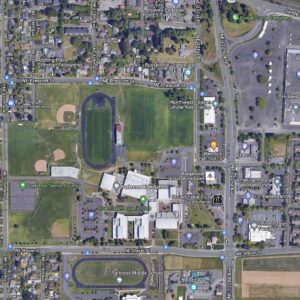
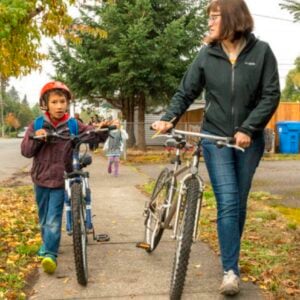
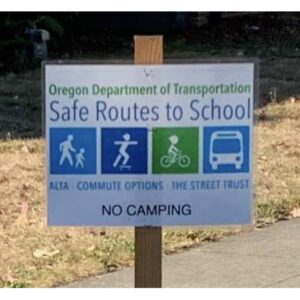
Thanks for reading.
BikePortland has served this community with independent community journalism since 2005. We rely on subscriptions from readers like you to survive. Your financial support is vital in keeping this valuable resource alive and well.
Please subscribe today to strengthen and expand our work.
Woo yeah! So Carl is getting a raise huh? If anyone deserves one it’s him.
but srsly less cars=less crashes, who would a thunk it
just imagine if we could extend the school zones a block or two beyond the boundaries of the school itself, and if we could get local control of speed limits
Howdy–
The only trouble with the increased funding for SR2S is that once the feds got hold of it, the money was diverted to infrastructure projects. As I recall, only 25 percent of federal grants can go toward salaries, the rest has to go to concrete. That’s silly. If you give me $250,000, I can spend the next ten years, at $25,000 a year (or five years at $50,000, you get the idea) supporting the local school district with programs and events. One energetic person (okay, it might not be me) could create something from nothing with that kind of money. On the other hand, a quarter of a million dollars will only buy a couple of blocks of bikeway. It’s really sad that the only thing that makes sense to transportation officials is more infrastructure. That’s the philosophy of DOTs, who want to pave more roads, to get more gas tax, to pave more roads.
On another note, what’s that ridiculous gesture those kids are making in the first photo? Oregon is progressive enough to recognize that the left hand waving vaguely in the air is an ineffective right turn signal. It’s a holdover from the days before cars and motorcycles had turn signal lights. Drivers had to use their left hands to signal a right turn because they couldn’t reach the right side of the car to signal out the passenger window. Motorcyclists needed to signal with the left hand so as not to lose control of the throttle, which is on the right. For cyclists, it makes much more sense to point where you’re going, right or left, and it’s legally codified. I hope advocates can catch up with that improvement.
Happy Trails,
Ron Georg
Corvallis
@Ron – #3, I too noted the hand signal in the photo. As another Corvallis rider, I help out with the BTA bike safety classes that are presented to our fifth graders and I can assure you that Greg, our local instructor, teaches the ‘point where you’re going’ signal. This photo looks like one of the BTA classes (standard loaner bikes, pinnys on the kids, masking tape with names on the helmets) and it is tagged from 2006. I hope all the instructors are now teaching the more modern signals.
i really think we should reconsider those hand signals. i just point the direction im going. im a cyclist and i dont even know what those 90 degree angles mean…just point, that way you can say “im going straight” as well
I noticed on the “Safe routes maps” that they used main arterial rts instead of the less used side streets that would be safer rts for little kids. good intention, could be better though. hopefully a work in progress that will continue to improve each year.
that is the only signal I recognize as a legitimate signal, anything else is just a made up gesture. There is no signal for going straight ahead, nor is there a signal for blasting through stop signs.